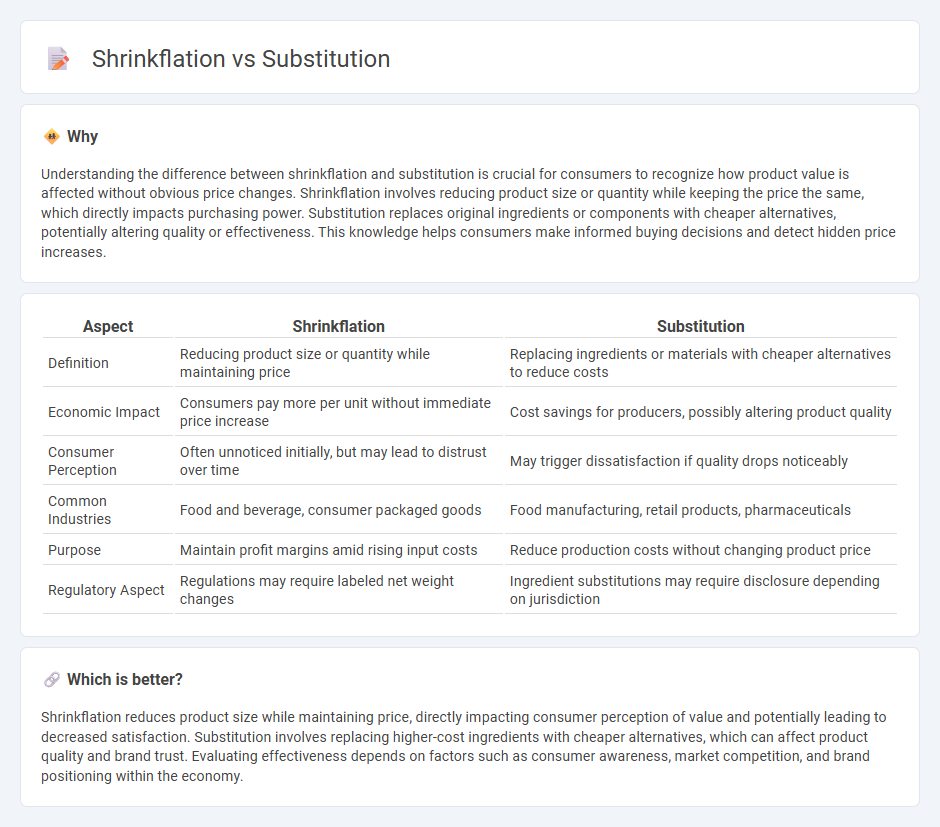
Shrinkflation describes the practice where companies reduce product sizes or quantities while maintaining prices, effectively increasing the cost per unit for consumers. Substitution involves replacing higher-cost ingredients or materials with cheaper alternatives to manage production expenses without altering product pricing. Explore these economic strategies to understand their impact on consumer behavior and market dynamics.
Why it is important
Understanding the difference between shrinkflation and substitution is crucial for consumers to recognize how product value is affected without obvious price changes. Shrinkflation involves reducing product size or quantity while keeping the price the same, which directly impacts purchasing power. Substitution replaces original ingredients or components with cheaper alternatives, potentially altering quality or effectiveness. This knowledge helps consumers make informed buying decisions and detect hidden price increases.
Comparison Table
| Aspect | Shrinkflation | Substitution |
|---|---|---|
| Definition | Reducing product size or quantity while maintaining price | Replacing ingredients or materials with cheaper alternatives to reduce costs |
| Economic Impact | Consumers pay more per unit without immediate price increase | Cost savings for producers, possibly altering product quality |
| Consumer Perception | Often unnoticed initially, but may lead to distrust over time | May trigger dissatisfaction if quality drops noticeably |
| Common Industries | Food and beverage, consumer packaged goods | Food manufacturing, retail products, pharmaceuticals |
| Purpose | Maintain profit margins amid rising input costs | Reduce production costs without changing product price |
| Regulatory Aspect | Regulations may require labeled net weight changes | Ingredient substitutions may require disclosure depending on jurisdiction |
Which is better?
Shrinkflation reduces product size while maintaining price, directly impacting consumer perception of value and potentially leading to decreased satisfaction. Substitution involves replacing higher-cost ingredients with cheaper alternatives, which can affect product quality and brand trust. Evaluating effectiveness depends on factors such as consumer awareness, market competition, and brand positioning within the economy.
Connection
Shrinkflation and substitution are interconnected economic phenomena where shrinkflation involves reducing product size or quantity while maintaining price, leading consumers to seek substitutes as a cost-saving measure. Substitution occurs when consumers replace higher-priced or reduced-value goods with more affordable alternatives, directly influenced by the perception of decreased value from shrinkflation. Both trends reflect responses to inflationary pressures and impact consumer purchasing behavior, pricing strategies, and market competition.
Key Terms
Consumer Choice
Substitution often involves replacing higher-cost ingredients with cheaper alternatives without changing the product size, impacting taste and quality, while shrinkflation reduces product quantity or size but keeps the price constant, affecting perceived value. Both practices influence consumer choice by altering product expectations and satisfaction, ultimately shaping brand loyalty and purchasing decisions. Explore further to understand how these strategies affect market dynamics and consumer behavior.
Product Quantity
Substitution involves replacing original product ingredients or components with cheaper alternatives to maintain price, while shrinkflation reduces the product quantity or size without proportionally lowering the price, effectively increasing the unit cost. Both strategies aim to manage costs and preserve profits amid rising expenses but impact consumer perception differently, with shrinkflation often more noticeable due to smaller portions. Discover more about how these practices affect product value and consumer choices.
Relative Pricing
Relative pricing shifts reveal substitution effects where consumers choose lower-priced alternatives as product quality or quantity changes, impacting overall spending patterns. Shrinkflation, characterized by reducing product size while maintaining price, distorts relative value perception, often misleading consumers about true cost increases. Explore how relative pricing influences consumer behavior and market strategies in these phenomena.
Source and External Links
Substitution in Algebra - Substitution means replacing letters with numbers in algebraic expressions to simplify or evaluate them, such as putting x=2 into 10/x + 4 to get 9.
Substitution (logic) - In logic and algebra, substitution is the consistent replacement of variables with values or expressions, often used for evaluating polynomials or transforming formal expressions.
SUBSTITUTION definition | Cambridge English Dictionary - Substitution is the act of using something new or different instead of something else, commonly used to avoid repetition in speech and writing by replacing words or phrases with substitutes.
 dowidth.com
dowidth.com